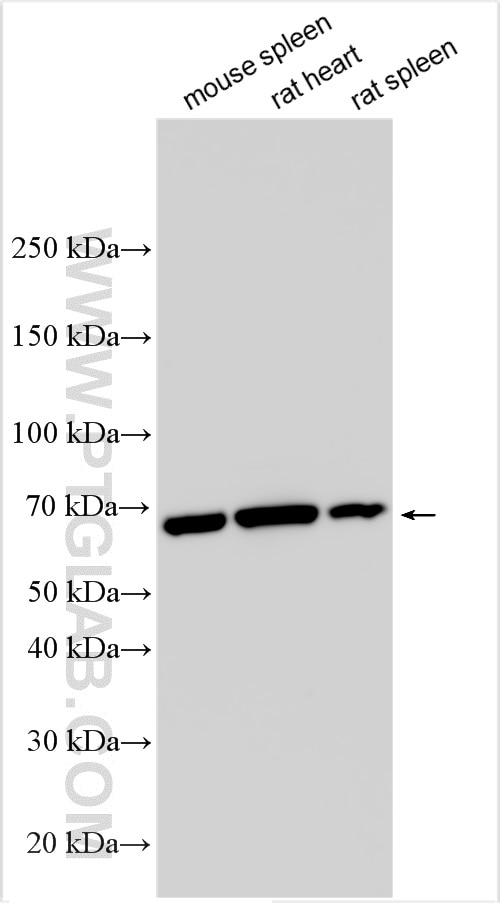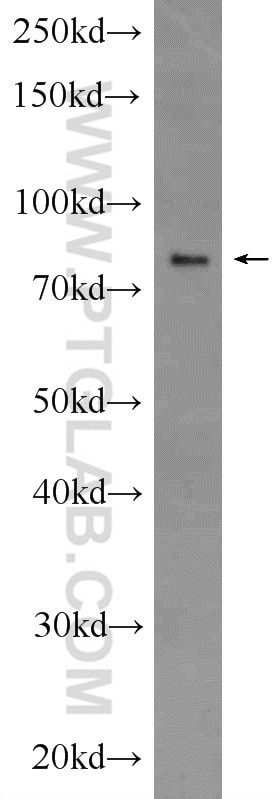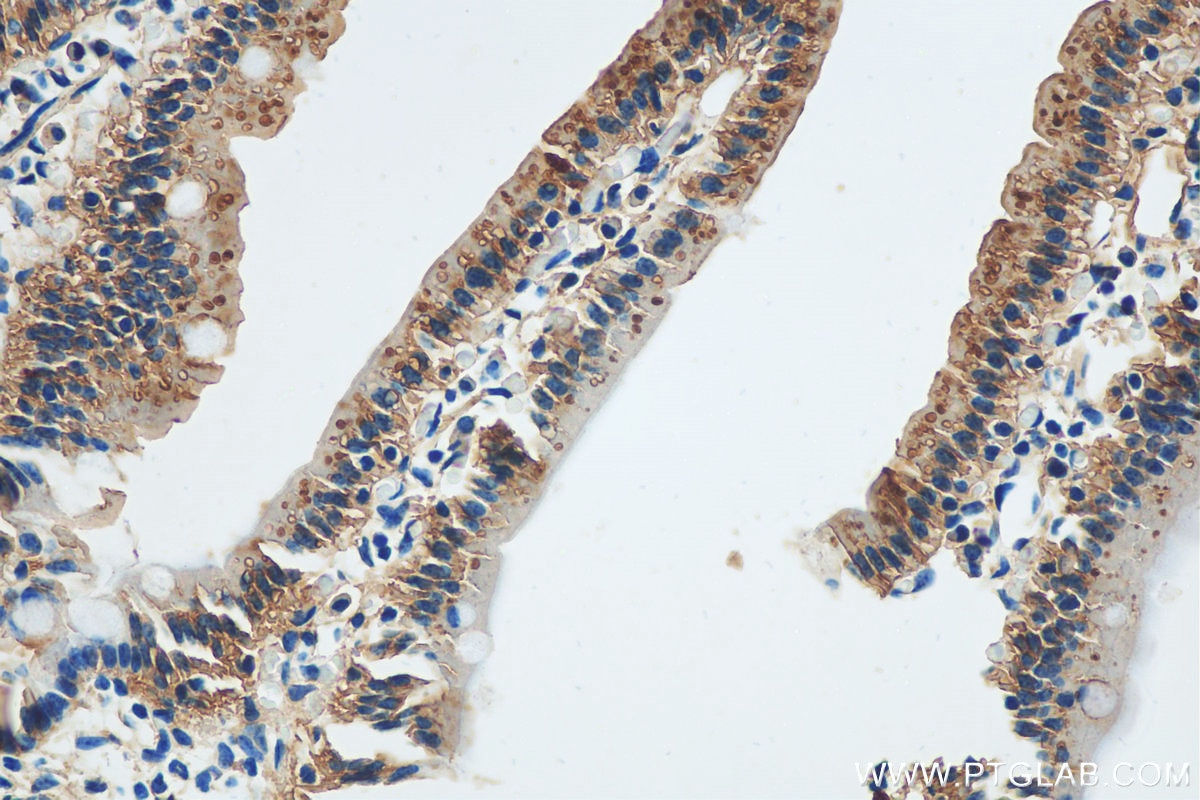- Featured Product
- KD/KO Validated
RIPK1-Specific Polyklonaler Antikörper
RIPK1-Specific Polyklonal Antikörper für WB, IHC, ELISA
Wirt / Isotyp
Kaninchen / IgG
Getestete Reaktivität
Maus, Ratte und mehr (3)
Anwendung
WB, IHC, IF, IP, CoIP, ELISA
Konjugation
Unkonjugiert
Kat-Nr. : 17519-1-AP
Synonyme
Geprüfte Anwendungen
| Erfolgreiche Detektion in WB | Mausmilzgewebe, Rattenherzgewebe, Rattenlebergewebe, Rattenmilzgewebe |
| Erfolgreiche Detektion in IHC | Maus-Dünndarmgewebe Hinweis: Antigendemaskierung mit TE-Puffer pH 9,0 empfohlen. (*) Wahlweise kann die Antigendemaskierung auch mit Citratpuffer pH 6,0 erfolgen. |
Empfohlene Verdünnung
| Anwendung | Verdünnung |
|---|---|
| Western Blot (WB) | WB : 1:1000-1:8000 |
| Immunhistochemie (IHC) | IHC : 1:50-1:500 |
| It is recommended that this reagent should be titrated in each testing system to obtain optimal results. | |
| Sample-dependent, check data in validation data gallery | |
Veröffentlichte Anwendungen
| KD/KO | See 1 publications below |
| WB | See 123 publications below |
| IHC | See 16 publications below |
| IF | See 21 publications below |
| IP | See 6 publications below |
| CoIP | See 4 publications below |
Produktinformation
17519-1-AP bindet in WB, IHC, IF, IP, CoIP, ELISA RIPK1-Specific und zeigt Reaktivität mit Maus, Ratten
| Getestete Reaktivität | Maus, Ratte |
| In Publikationen genannte Reaktivität | human, Hausschwein, Hefe, Maus, Ratte |
| Wirt / Isotyp | Kaninchen / IgG |
| Klonalität | Polyklonal |
| Typ | Antikörper |
| Immunogen | Peptid |
| Vollständiger Name | receptor (TNFRSF)-interacting serine-threonine kinase 1 |
| Berechnetes Molekulargewicht | 76 kDa |
| Beobachtetes Molekulargewicht | 70-80 kDa |
| GenBank-Zugangsnummer | NM_003804 |
| Gene symbol | RIPK1 |
| Gene ID (NCBI) | 8737 |
| Konjugation | Unkonjugiert |
| Form | Liquid |
| Reinigungsmethode | Antigen-Affinitätsreinigung |
| Lagerungspuffer | PBS with 0.02% sodium azide and 50% glycerol |
| Lagerungsbedingungen | Bei -20°C lagern. Nach dem Versand ein Jahr lang stabil Aliquotieren ist bei -20oC Lagerung nicht notwendig. 20ul Größen enthalten 0,1% BSA. |
Hintergrundinformationen
RIPK1(Receptor-interacting serine/threonine-protein kinase 1) is primarily involved in mediating TNF-R1-induced cell activation, apoptosis, and necroptosis and belongs to a novel class of kinases that function in cell survival and cell death mechanisms(PMID:22685397 ). It has 2 isoforms produced by alternative splicing. It also can exist as a protein with a lower molecular weight of about 25 kDa and 45 kDa in HAEC and HUVEC(PMID:22685397).
Protokolle
| PRODUKTSPEZIFISCHE PROTOKOLLE | |
|---|---|
| WB protocol for RIPK1-Specific antibody 17519-1-AP | Protokoll herunterladen |
| IHC protocol for RIPK1-Specific antibody 17519-1-AP | Protokoll herunterladenl |
| STANDARD-PROTOKOLLE | |
|---|---|
| Klicken Sie hier, um unsere Standardprotokolle anzuzeigen |
Publikationen
| Species | Application | Title |
|---|---|---|
Acta Pharm Sin B A new perspective of triptolide-associated hepatotoxicity: the relevance of NF- κ B and NF- κ B-mediated cellular FLICE-inhibitory protein. | ||
Nat Commun Regulation of RIPK1 activation by TAK1-mediated phosphorylation dictates apoptosis and necroptosis. | ||
Sci Total Environ Evaluation of 6-PPD quinone toxicity on lung of male BALB/c mice by quantitative proteomics | ||
Sci Total Environ Glycidol induces necroptosis and inflammation through autophagy-necrosome pathway in renal cell and mice | ||
Cancer Res Proteomic mapping and targeting of mitotic pericentriolar material in tumors bearing centrosome amplification. |
Rezensionen
The reviews below have been submitted by verified Proteintech customers who received an incentive for providing their feedback.
FH Yuan (Verified Customer) (01-07-2020) | This RIPK-1 antibody was tried on the MCF7 tamoxifen resistant (5uM) cell line, the 74 kDa band was very faint, but the 45 kDa band is clear. In addition, some unspecific bands near 45 kDa showed up too.
|




